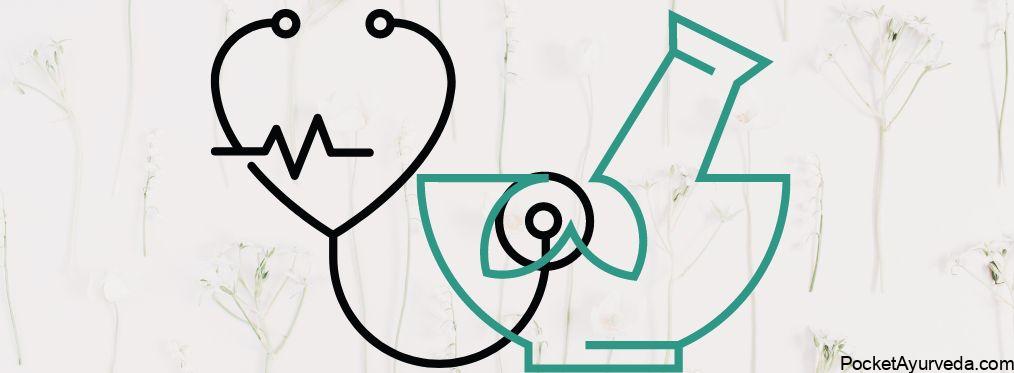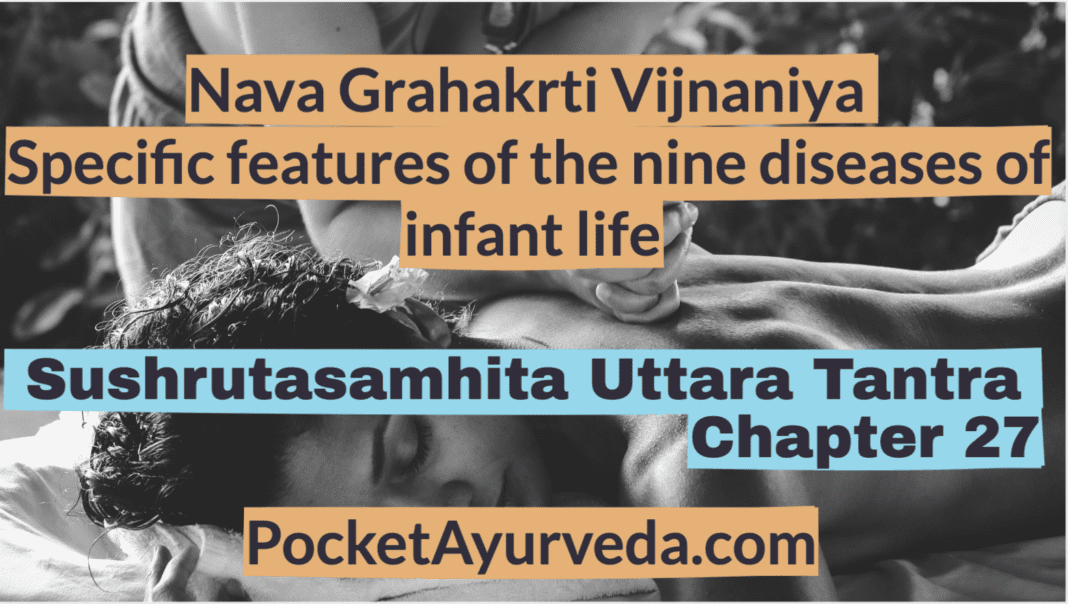सप्तविंशोऽध्यायः अथातो नवग्रहाकृतिविज्ञानीयमध्यायं व्याख्यास्यामः यथोवाच भगवान् धन्वन्तरिः ॥ १ ॥
Now we shall discourse on the chapter which deals with the specific features (of the nine diseases of infant life, which are attributed to the influences) of the nine malignant Grahas (Nava-Grahakrti Vijnaniya). 1.
बालग्रहाणां विज्ञानं साधनञ्चाप्यनन्तरम् । उत्पत्तिं कारणञ्चैव सुश्रुतैकमनाः श्रृणु ॥ २ ॥ स्कन्दग्रहस्तु प्रथमः स्कन्दापस्मार एव च । शकुनी रेवती चैव पूतना चान्धपूतना ॥ ३ ॥ पूतना शीतनामा च तथैव मुखमण्डिका । नवमो नैगमेषश्च यः पितृग्रहसंज्ञितः ॥ ४ ॥
Different Names – Attentively hear me Susruta! describing the origin, cause and medical treatment of the diseases of infancy which are due to the influences of malignant stars (Graha) or demons as well as the characteristic symptoms by which each can be accurately diagnosed. The diseases number nine in all and are called SkandaGraha, Skandapasmara, Sakuni, Revati, Putana, Andha-Putana, Sita-putana, Mukha-mandika and Naigamesa or Pitr-Graha.
धात्रीमात्रोः प्राक्प्रदिष्टापचाराच्छौचभ्रष्टान् मङ्गलाचारहीनान् । त्रस्तान् हृष्टांस्तर्जितान् ताडितान् वा पूजाहेतोर्हिस्युरेते कुमारान् ॥ ५ ॥
ऐश्वर्य्यस्थास्ते न शक्या विशन्तो देहं द्रष्टं मानुषैर्विश्वरूपाः । आप्तं वाक्यं तत्समीक्ष्याभिधास्ये लिङ्गान्येषां यानि देहे भवन्ति ॥ ६ ॥
General course of attack – These malignant stars ( Grahas) or demons affect the person of a child in the cases where the directions laid down before (in the Sarira-sthana) in respect of the conduct of the mother or the nurse during the time the child is brought up on the breast are not followed and consequently where proper benedictory rites are not performed and the child is allowed to remain in an uncleanly state, or where the child becoming anyhow uneasy state, or where the child becoming anyhow uneasy gets frightened, is rebuked, or begins to cry. They (demons) make their appearance for the purpose of getting proper respect and worship. They being omnipotent and omnipresent are not capable of being seen by man when they enter the person of a child. I should, therefore, discourse on the symptoms or their presence, as derived from the authority of the sages of yore. 5-6.
Symptoms of attack by Skandagraha and Skandapasmaragraha
शूनाक्षः क्षतजसगन्धिकः स्तनद्विड् वक्रास्यो हतचलितैकपक्ष्मनेत्रः । उद्विग्नः सुलुलितचक्षुरल्परोदी स्कन्दार्तो भवति च गाढमुष्टिवर्चाः ॥ ७॥ निःसंज्ञो भवति पुनर्भवेत् ससंज्ञः संरब्धः करचरणैश्च नृत्यतीव । विण्मूत्रे सृजति विनद्य जृम्भमाणः फेनञ्च प्रसृजति तत्सखाभिपन्नः ॥ ८ ॥
Symptoms of attack by Skandagraha and Skandapasmaragraha – Swelling of the eyes and distorted features of the face and an aversion to the breast-milk are the indications of an attack by the Skanda-graha. The body of the child emits a bloody smell and one of the eyelids becomes fixed or motionless. The child looks frightened, closes his fists (as in a fit of convulsion) and moans a little. The eyes become highly rolling and the stool becokmes hard and constipated. Altemate fits of fainting and consciousness, convulsive jerks of legs and hands like those in dancing, foaming (at the mouth), yawning and the passing of stool and urine with the passage of wind are the characteristic features of an attack by the Skanda-pasmara-graha. 7-8.
Sakuni and Revati
स्त्रस्ताङ्गो भयचकितो विहङ्गगन्धिः संस्त्राविव्रणपरिपीडितः समन्तात् । स्फोटैश्च प्रचिततनुः सदाहपाकैर्विज्ञेयो भवति शिशुः क्षतः शकुन्या ॥ ९॥ रक्तास्यो हरितमलोऽतिपाण्डुदेहः श्यावो वा ज्वरमुखपाकवेदनार्तः । रेवत्या व्यथिततनुश्च कर्णनासं मृनाति ध्रुवमभिपीडितः कुमारः ॥ १०॥
Sakuni and Revati – Looseness of limbs which emit a peculiar bird-like¹ smell are the indications of an attack of the child by the Sakuni Graha. The child in such a case starts up in terror and its body is covered with a large number of secreting ulcers (Vrana), or of eruptions of vesicles attended with a burning sensation subsequently suppurting and bursting of themselves. The face assumes a blood-red hue, the stool (as well as the urine) becomes green and the body of the child looks as if of deep yellow or dark brown colour fever ensures with an inflamation of the mouth, a bruised pain is felt all over the body and the child frequently rubs its nose and ears- these are the features which mark a sure attack of Revati-Graha. 9-10.
Putana and Andha-putana
स्त्रस्ताङ्गः स्वपिति सुखं दिवा न रात्रौ विभिन्नं सृजति च काकतुल्यगन्धिः । छदर्यात हृषिततनूरुहः कुमारस्तृष्णालुर्भवति च पूतनागृहीतः ॥ ११ ॥ यो द्वेष्टि स्तनमतिसारकासहिक्का-च्छर्दीभिर्ज्वरसहिताभिरर्द्यमानः । दुर्वर्ण: सततमधःशयोऽम्लगन्धिस्तं ब्रूयुर्भिषज इहान्धपूतनार्तम् ॥ १२ ॥
Putana and Andha-putana— Looseness of the limbs, disturbed sleep whether by day or at night, loose stools, emission of a crow-like smell from the body, vomiting, appearance of goose-flesh on the skin and thirst are the specific symptoms of an attack of the child by the Putana- Graha. Dislike for the breast-milk as well as an attack of diarrohea, (Atisara), cough, hic-cough, vomiting, fever, discolouring of the complexion and swelling in the skin as well as an inclination to lie always on the face are the symptoms which are exhibited in a case of an attack by the Andha-Putana-Graha. 11-12.
Sita-putana and Mukha-mandika
उद्विग्नो भृशमतिवेपते प्ररुद्यात् संलीनः स्वपिति च यस्य चान्त्रकूजः । विस्त्राङ्गो भृशमतिसार्यते च यस्तं जानीयाद् भिषगिह शीतपूतनार्तम् ॥ १३॥ म्लानाङ्गः सुरुचिरपाणिपादवक्त्रो बह्वाशी कलुषसिरावृतोदरो यः । सोद्वेगो भवति च मूत्रतुल्यगन्धिः स ज्ञेयः शिशुरिह वक्त्रमण्डिकार्तः ॥ १४॥
1. By the word विहङ्ग (lit, a bird) in विहङ्गगन्धिः is here meant meat eating aquatic birds.
Sita-putana and Mukha-mandika – Constant and frightened startling up, excessive shivering, comatose sleep, constant diarrheic stools and bloody smell are characteristic of an attack by Sita-putana. The child in this case cries almost unceasingly, and a rumbling sound is heard in the intestines. Paleness (emaciation) of the body (trunk) and a glossy line (swelling) of the face and the extremities attended with frightfulness, voracious appetite, appearance of net-like venous engorgement over the abdomen and emission of urine like small from the body are the symptoms of an attack of the child by Mukha-mandika Graha. 13-14.
Naigamesa Graha
यः फेनं वमति विनम्यते च मध्ये सोद्वेगं विलपति चोर्ध्वमीक्षमाणः ।
ज्वर्येत प्रततमथो वसासगन्धिर्निःसंज्ञो भवति हि नैगमेषजुष्टः ॥ १५ ॥
Naigamesa Graha – Frothy vomits, bending of the middle of the trunk, anxious appearance, loud crying, upward gaze of the eyes, constant emaciation (fever D.R.), a fatty smell in the body and unconsciousness are the symptoms which mark a case of an attack by the Naigamesa. 15.
प्रस्तब्धो यः स्तनद्वेषी मुह्यते चाविशन् मुहुः । तं बालं न चिराद्धन्ति ग्रहः सम्पूर्णलक्षणः ॥ १६ ॥
Prognosis- A stupified state of the child attended with an aversion to breast-milk and constant fits of fainting as well as the full development of all the specific symptoms show the imminent fatal termination of the disease. Otherwise it may prove amenable to medical treatment, if it be not a case of long standing. 16.
Rules to be observed
विपरीतमतः साध्यं चिकित्सेदचिरार्दितम् । गृहे पुराणहविषाऽभ्यज्य बालं शुचौ शुचिः ॥ १७ ॥ सर्षपान् प्रकिरेत् तेषां तैलैर्दीपञ्च कारयेत् | सदा सन्निहितञ्चापि जुहुयाद्धव्यवाहनम् ॥ १८ ॥ सर्वगन्धौषधीबीजैर्गन्धमाल्यैरलड्कृतम् । अग्नये कृत्तिकाभ्यश्च स्वाहा स्वाहेति सन्ततम् ॥ १९ ॥ नमः स्कन्दाय देवाय ग्रहाधिपतये नमः । शिरसा त्वाऽभिवन्देऽहं प्रतिगृह्णीष्व मे बलिम् ॥ २० ॥ नीरुजो निर्विकारश्च शिशुमें जायतां ध्रुवम् ॥ २१ ॥
Rules to be observed – The child should be kept in a clean and purified chamber and its body should be rubbed or anointed with old and matured clarified butter. Mustard seeds should be strewn all over the floor (by a person) in a clean state and a lamp of mustard oil should be kept perpetually burning therein. Libations of clarified butter with the drugs of the Sarvagandha and Sarvousadhi¹ groups and garlands of flowers as well as sandal paste should be cast into the fire and kept continually burning by reciting the following incantations, “Obeisance to thee, O fire-god, obeisance to thee, O goddess Krttika, obeisance to thee, O Skanda, obeisance to thee, O lord of the Grahas (which has cast this malignant influence). With head down with deep humility, I supplicate thy favour. Dost thou accept the offerings I have made to thee. May my child get rid of the disease it has been suffering from. Makest it hale and hearty again.” 17-21.
इति सश्रुत संहितायामुत्तरतन्त्रे नवग्रहाकृतिविज्ञानीयव्याख्यानाम सप्तविंशोऽध्यायः ॥ २७ ॥
Thus ends the twenty-seventh chapter of the Uttara-Tantra in the Susruta-Samhita whith deals with the spefific features of an attack by the nine (malignant) Grahas.
1. The drugs of the Eladi group are known as Sarva-gandha. Sarvausadhi drugs here mean Yava, Dhanya, Tila, etc.




